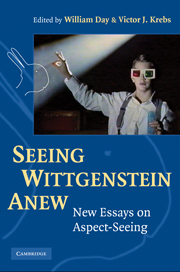Book contents
- Frontmatter
- Contents
- List of Contributors
- Acknowledgments
- Abbreviations of Wittgenstein's Works
- Seeing Wittgenstein Anew
- Introduction: Seeing Aspects in Wittgenstein
- I ASPECTS OF “SEEING-AS”
- II ASPECTS AND THE SELF
- III ASPECTS AND LANGUAGE
- IV ASPECTS AND METHOD
- IV.1 Therapy
- IV.2 Seeing Connections
- 14 Overviews
- 15 On Being Surprised
- 16 The Enormous Danger
- Appendix: A Page Concordance for Unnumbered Remarks in Philosophical Investigations
- List of Works Cited
- Index
14 - Overviews
What Are They of and What Are They For?
Published online by Cambridge University Press: 05 June 2012
- Frontmatter
- Contents
- List of Contributors
- Acknowledgments
- Abbreviations of Wittgenstein's Works
- Seeing Wittgenstein Anew
- Introduction: Seeing Aspects in Wittgenstein
- I ASPECTS OF “SEEING-AS”
- II ASPECTS AND THE SELF
- III ASPECTS AND LANGUAGE
- IV ASPECTS AND METHOD
- IV.1 Therapy
- IV.2 Seeing Connections
- 14 Overviews
- 15 On Being Surprised
- 16 The Enormous Danger
- Appendix: A Page Concordance for Unnumbered Remarks in Philosophical Investigations
- List of Works Cited
- Index
Summary
AN OVERVIEW OF OVERVIEWS
My interest in Wittgenstein's notion of problems which can be solved by “putting into order what we already know without adding anything,” i.e., by overviews, is not merely exegetical. I address the notion of the nature and point of overviews because of its resonance. When I first encountered Wittgenstein's contrast between perplexities that require empirical explanation and those which could not be so relieved, but would only yield to a “perspicuous view,” I felt like Moliere's M. Jourdain at his first encounter with the concept of prose and his realization that he had been talking it all his life. Wittgenstein's remarks, and their exemplification in his comments on Frazer's Golden Bough, alerted me to the extent of our indebtedness to those who, in the words of Orwell's tribute to James Joyce, “open[ed] up a new world not by revealing what is strange, but by revealing what is familiar.”
When I consider the overviews which I have frequented and striven to create, they seem to fall into two broad categories: the heuristic-explanatory and the self-clarificatory. Wittgenstein's remarks on magic and ritual sacrifice fall into the same two categories. When he reminds us, in connection with effigy-burning, that we kiss pictures of our loved ones, he is contributing to an heuristic-explanatory overview; when he tells us that, in responding to the Beltane fire festivals, it is not their genesis from a practice in which men were really burned which is the source of our uneasiness, but something intrinsic to the festivals themselves, he is clarifying our impression of the festivals by laying out rival determinants – cognitive and physiognomic.
Keywords
- Type
- Chapter
- Information
- Seeing Wittgenstein Anew , pp. 291 - 313Publisher: Cambridge University PressPrint publication year: 2010
- 3
- Cited by

